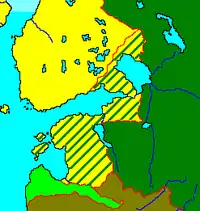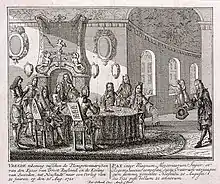Treaty of Nystad
The Treaty of Nystad (Russian: Ништадтский мир; Finnish: Uudenkaupungin rauha; Swedish: Freden i Nystad; Estonian: Uusikaupunki rahu) was the last peace treaty of the Great Northern War of 1700–1721. It was concluded between the Tsardom of Russia and the Swedish Empire on 10 September [O.S. 30 August] 1721 in the then Swedish town of Nystad (Finnish: Uusikaupunki, in the south-west of present-day Finland). Sweden had settled with the other parties in Stockholm (1719 and 1720) and in Frederiksborg (1720).
 Treaty effects: pre-war Sweden in yellow, Russia in green, Russian gains indicated by lines. | |
| Signed | 10 September [O.S. 30 August] 1721 |
|---|---|
| Location | Nystad, Sweden. Today Uusikaupunki, Finland |
| Original signatories | |

During the war Peter I of Russia had occupied all Swedish possessions on the eastern Baltic coast: Swedish Ingria (where he began to build the soon-to-be Russian capital of St. Petersburg in 1703), Swedish Estonia and Swedish Livonia (which had capitulated in 1710), and Finland.
In Nystad, King Frederick I of Sweden formally recognized the transfer of Estonia, Livonia, Ingria, and Southeast Finland (Kexholmslän and part of Karelian Isthmus) to Russia in exchange for two million silver thaler, while Russia returned the bulk of Finland to Swedish rule.[1][2]
The Treaty enshrined the rights of the German Baltic nobility within Estonia and Livonia to maintain their financial system, their existing customs border, their self-government, their Lutheran religion, and the German language; this special position in the Russian Empire was reconfirmed by all Russian Tsars from Peter the Great (reigned 1682-1725) to Alexander II[3] (reigned 1855-1881).
Nystad manifested the decisive shift in the European balance of power which the war had brought about: the Swedish imperial era had ended; Sweden entered the Age of Liberty, while Russia had emerged as a new empire.
Legacy
In pre-1917 Saint Petersburg, in the Vyborgsky district (relatively nearest to Russo-Finnish border) one of the thoroughfares (now Lesnoy prospekt) was named after the Nystad treaty (Nystadt Street, Rus. Ништадтская улица).[4] The district also houses a church commemorating the first Russian victory in the Great Northern war, the Battle of Poltava – St. Sampsonius' Cathedral.
See also
References
- Russian: РГАДА. Рукописный отдел библиотеки Московской Синодальной типографии. Фонд 381, ед.хр.805. Л.6. Original handwritten text of the Treaty of Nystad in Russian
- (in Russian) Ништадтский мирный договор между Россией и Швецией, 30 августа 1721 г. Text of the Treaty of Nystad in Russian
- Ragsdale, Hugh; V. N. Ponomarev (1993). Imperial Russian foreign policy. Cambridge University Press. p. 42. ISBN 978-0-521-44229-9.
- Лев Успенский. Записки старого петербуржца. (Lev Uspenskii. Zapiski starogo peterburjca.) Any edition.
External links
- Freden i Nystad – Ништадтский мир 1721 – Uudenkaupungin rauha 1721. Trilingual source publication (Swedish, Russian, Finnish) of the documents concerning the peace treaty from The Russian Foreign Ministry Archives. Published by Agricola – The Finnish History Network publication series number 10. 2014 (Heidi Pitkänen red.)
- "Freden i Nystad 1721 :: Agricola ::". Archived from the original on 15 April 2014.
- Ништáдтский мир 1721 :: Agricola ::, Archived from the original on 2 Jan 2015.
- Uudenkaupungin rauha 1721.
- International conference ‘The Border of the Treaty of Nystad – Peter the Great’s Line’ dedicated to the Tercentenary of the Great Northern War’s end and the making of the Treaty of Nystad. Vyborg, Leningrad Region. October 7-8, 2021 The Conference is dedicated to the Tercentenary of the Great Northern War’s, making of the Treaty of Nystad and demarcation of the border between Russia and Sweden in 1722. The aim of the conference is to thoroughly study the history of the border demarcation between Russia and Sweden, its influence on the historical and cultural heritage in the borderline territories, to draw attention to the problems of preservation of monuments dated back to the Peter the Great’s period as well to expand co-operation between Russian and European researchers in studying Peter I’s period.
Vyborg, Leningrad Region. October 7-8, 2021

